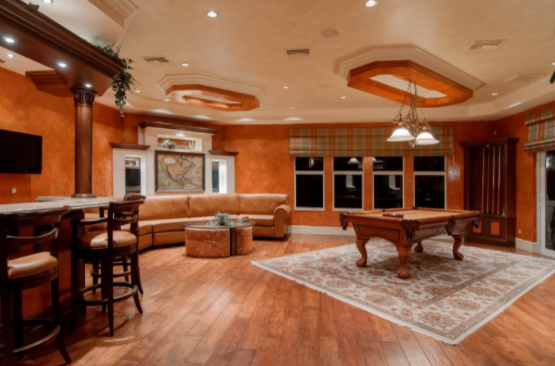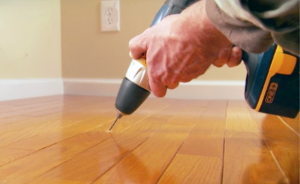Why Is My Hardwood Floor Creaking?
February 23, 2022
Hardwood floors are known for their long-term durability. Even so, they’re not immune to age and general wear and tear. Whether from constant use or just from growing older, you will find that eventually the boards will start to creak. In this article, we will discuss everything you need to know about creaky floors so you can decide for yourself if you have an issue that needs addressing.
What Causes Squeaky Floors?
There are a wide variety of completely different reasons why your floor could be squeaking. Let’s get into some reasons why this might be happening.
Seasonal Changes
As the seasons progress from one to the next, the temperature changes. In the winter, the air getting colder can cause even brand new boards to squeak a little. This is because as the cold and dry winter air, the boards will naturally contract a bit, becoming smaller. This creates tiny gaps between the boards and even the subfloor.
This contraction results in the boards being able to move more and rub against each other or even the fasteners. Seasonal squeaks are nothing to worry about and typically go away as soon as it starts getting warmer. You can mitigate this issue quite well by just keeping the humidity of the room between 40 and 60 percent.
Joist Problems
If you didn’t know already, joists are basically a small structure that sits beneath both the floor and subfloor. They are horizontal bars that help stabilize your subfloor and help prevent it from moving around. Any issues with the joists can cause the flooring to become looser and create creaking.
Some problems the joists may have include them being too loose, getting warped, or gaps forming between them and the subfloor. The easiest way to verify this is to have access to a basement below the boards and the room beneath the boards.
Subfloor Problems
Uneven subfloors are one of the most common ways that a squeaky floor can happen. When the subfloor is not level with everything else, it creates a gap between itself and what’s above it. This naturally allows for the board above it to move around and create noise. Another culprit may be that the joists and the subfloor are misaligned.
If you think that the joists may be the source of the issue, then the best thing you can do is get it repaired or replaced by a professional. Damaging your subfloor through accidental damage is a mistake you very much don’t want to make.
When you boil all this down to the simple basics, it always comes down to the fact that the board is becoming loose and moving around to some degree.
Are Squeaky Floors a Sign of Danger to the Structure?
Fortunately, creaky floors are basically never a sign that something is about to actually break. Squeaking does not mean that there is structural damage. If the floor was also bending or bowing in some way, then that would definitely be an issue, but by that point, you wouldn’t need the squeaking to see that happening anyway.
Any floor of any type can squeak, but hardwood floors and stairs are usually what it’s happening with. Squeaks happen when the house is settling after a change in temperature and the boards start to dry out and expand. This in turn causes the floorboards to start to rub against each other, the nail casings, or even the subfloor.
Thankfully, creaky floors are also typically really trivial to fix.
How To Fix Your Creaky Floorboards

source: unsplash
To figure out exactly where the boards that creak are, you will definitely need a second person. The reason for this is quite simple. You can’t both be on top of the boards, walking around to make them squeak, and be on the floor below to pinpoint where the board is.
An unfinished basement or crawl space is ideal for this job since it means that all you need to have on you is some carpenter’s glue or any other construction adhesive as well as a thin wood shim. All you’d need to do is smear some of the adhesive onto the shim and gently tap it into position between the joists and subfloor. If that’s not easy to do, then you can also just jam directly between the bad boards and good ones adjacent to it.
If you end up finding that the gap is too large for a shim to work, don’t fret. There’s another great alternative as well. Get your caulking gun and simply apply the adhesive between the subfloor and the joist. Once it’s all hardened, the squeaking should be a complete thing of the past.
If the cause of the squeaking is because the boards are actively rubbing against the wooden subfloor below it, there is an admittedly more tricky option you can take to fix it. Take a short wooden screw and drive it through the bottom of the subfloor and into the base of it. Take it slow and be careful, you will want to ensure that the screw does not go too far in, as you risk the bottom of the screw sticking up out of the floor where you could step on it.
For stairs, one reliable way to fix the creaking is to access the back of the stairs where you can get under them and then, using the shims and glue we mentioned earlier, tap them into the joints between the treads and the risers. If you are for some reason unable to get under the boards, then you can do this from above as well, but you will want to make sure to trim the exposed parts afterward with a utility knife. If all else fails, you could just try applying adhesive directly on top of the boards, but you will also want to do this carefully to avoid a big mess and an annoying cleanup.
Fixing Creaky Floors From Above
You will notice that we didn’t put much emphasis on doing these fixes from above. The issue is that if you can’t get below the boards, you may have some difficulty that requires more precision than you would need otherwise.
One good method is to buy either ring-shank flooring nails (recognizable from the little rings that cover it) or cement-covered flooring nails, then hammer them into the seams between the bad boards. If what’s causing the squeak is the board coming detached from the subfloor, you can try hammering two nails at opposite 45-degree angles into the joists and filling in the holes with wood filler.
Final Thoughts
The sound of creaking can be rather unpleasant. With proper maintenance, your hardwood floor can stay in top condition for as long as you let it. If you’re in Colorado and you haven’t already done so, you can get a quote on your unique flooring needs by using this link or by calling us at (800) 639-3006.






